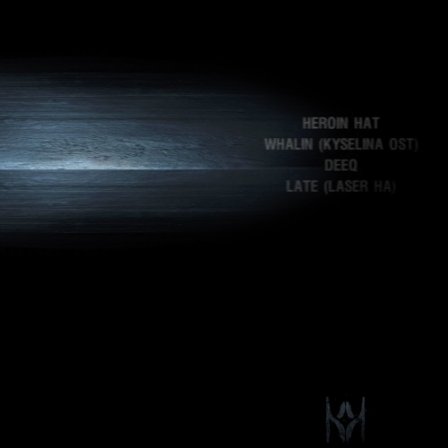Kyselina,, the machinist 3D artist responsible for some of the most compelling music-related art this year, captures sound in his warped visions — visions in perfect extensive harmony to the music he works with. Often, these images carry as much sonic context as the actual soundworks they accompany. The artist depicts hulking, metal figures dripping with corrosive liquid and rusted assemblages brimming with unknown plantlife. Even more, there are forest scenes with living bark and heavily ornamented wax seals alongside leather books. Take one look at the Catching Fire poster set he designed for Dan Bodan, and you’ll see gothic archways and creatures with feathery, neural spines growing from oblong vertebrae. It’s this surreal visuality that balances sickly detail, vision, and a pre-existing context that can be mutated, manipulated, and re-rendered.
In the music of Why Be, a.k.a. Copenhagen producer Tobias Lee, we can begin to see the map to this disparate visuality that has manifested itself across the network of progressive, “open-DAW” producers who have expanded new aesthetics unto cataclysmic planes in the past few years. Do a little digging, and you’ll find Lee’s relationship to the Sygnok collective fronted by HVAD, the Janus affiliate who forged his “002” mix as a fiery page in the doomsday tome carefully penned by the continental collective. Soon after, Bekelé Berhanu released “003,” a mix that featured Kyselina’s next visual masterwork: a toothy, moss-covered tree. Of course, Lotic established a firm foundation in “001,” the mix that grew into the the glass, skeletal winged creature on his debut EP Heterocetera, also designed by Kyselina.
As the key visionair and brander for Rabit’s Halcyon Veil imprint, it would of course make sense that there is a firm visual thread between the machinic alterity conjured by Kyselina and Why Be’s own sound design. Despite the genius qualities of their previous collaborations, there is a distinct artistic relationship between the two’s methodologies. For one, the visual/sound environment of both artists speaks to their heavy harmonization between imagination and skill, the often playful manipulation of materials in a blithely technical manner that so rarely occurs within the nebulous mind zone of the working artist. Why Be takes familiar dance modules and skews its design slightly to suggest a more contaminated, evocative context; he subtly manipulates known forms as a means to more intuitive organic structures. In a way, it’s not dissimilar to Kyselina’s own manipulation of tropic 3D tendencies found in big-budget game design. Why Be’s use of modulated rhythm and atmosphere is oddly familiar, in the way Kyselina’s forest renderings speak to a domestic if not diseased context, and in the way a low-lit 3D candle next to leather-bound books seems equally comfortable and terrifying.
Snipestreet is as diseased as it is utilitarian. His rhythms generate in a manner that calls to mind the “naturalism” of stark hardware manipulation, yet there is clear digital degradation interspersed through his free use of sampled sounds that pockmark driving kicks, hi-hats, and claps. He plays with tempo modulation amidst cinematic atmospheres and often breaks firm patterns with unexpected whip cracks or Noh woodblocks. Opening track “Heroin Hat” is a fantastic revision of the groove. The kick descends heavy on the one amongst marimba covalently arpeggiated alongside the free-play of an open hi-hat; the hat is warped in such a way to suggest a breathy human voice. Intermittently, there are impact sounds culled from pirate-able sample packs, cuts of glass breaking, or pitched voices — classic rack sounds that are used both rhythmically and abstractly, not unlike the way Actress deconstructed hi-hats and fragile rack tools on R.I.P. Similarly, “Deeq” extends a driving 130bpm kick that flips forward alongside the chant of the “Ha,” the classic sample fueling a ravaged, scorched tonality. “Late (Laser Ha)” re-imagines the stomp into an anime-style “Ha” that enlivens the beat within the martial atmosphere of colored hair and blood-soaked bandages wrapped around clenched fists.
These moments are fantastically executed renditions of dance aesthetics explored extensively in 2015. Yet despite their semblance to similar or associated artists, there’s an odd “touch” to these tracks, something peculiarly located within visual tendencies that enliven the sounds with subtle weirdness. Unlike the case with much collage-oriented dance music, where samples often have a tendency to slip by unnoticed in an onslaught of new content, Why Be positions each sound for maximum impact, enhancing their visual presence as a hue or object-rendering — a clump of pink hair, a rusted medallion, a stack of unfamiliar coins. Perhaps his focus on reorienting and visually positioning sound in a rhythmic context is attached to him coming out of “an artistically visual background where the schools […] were always focused on having a lot of concepts as the foundation for any given project.” As Lee mentioned in an interview with critic Alexander Iadarola, “Music would be more dropping all the concepts and just doing something.” You can hear a tension between “dropping all the concepts” and exploring the implicit concepts embodied in his choice of sounds that are, despite all odds, visually flecked on the DAW with the impact of artists located across mediums. This artist is located in the desire for freedom, but freedom within a heavily contextualized setting that pragmatically uses the constant re-rendering, re-scripting, and re-orienting of sound happening in 2015. Like the complex, emblazoned forms that are rendered by Kyselina, Lee takes the trope — the robot, the tree, the motorcycle — and lets it rot and rust just enough as to inflect a new hue on the futurist aesthetic continuum.




